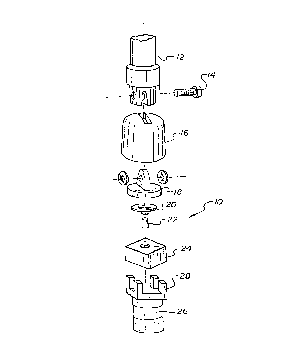Some of the information on this Web page has been provided by external sources. The Government of Canada is not responsible for the accuracy, reliability or currency of the information supplied by external sources. Users wishing to rely upon this information should consult directly with the source of the information. Content provided by external sources is not subject to official languages, privacy and accessibility requirements.
Any discrepancies in the text and image of the Claims and Abstract are due to differing posting times. Text of the Claims and Abstract are posted:
| (12) Patent: | (11) CA 2247418 |
|---|---|
| (54) English Title: | ANTENNA FOR A RADIO TELECOMMUNICATIONS DEVICE |
| (54) French Title: | ANTENNE POUR DISPOSITIF DE TELECOMMUNICATIONS PAR VOIE HERTZIENNE |
| Status: | Term Expired - Post Grant Beyond Limit |
| (51) International Patent Classification (IPC): |
|
|---|---|
| (72) Inventors : |
|
| (73) Owners : |
|
| (71) Applicants : |
|
| (74) Agent: | MARKS & CLERK |
| (74) Associate agent: | |
| (45) Issued: | 2001-01-09 |
| (86) PCT Filing Date: | 1997-03-04 |
| (87) Open to Public Inspection: | 1997-09-12 |
| Examination requested: | 1998-08-27 |
| Availability of licence: | N/A |
| Dedicated to the Public: | N/A |
| (25) Language of filing: | English |
| Patent Cooperation Treaty (PCT): | Yes |
|---|---|
| (86) PCT Filing Number: | PCT/CA1997/000155 |
| (87) International Publication Number: | WO 1997033338 |
| (85) National Entry: | 1998-08-27 |
| (30) Application Priority Data: | ||||||
|---|---|---|---|---|---|---|
|
A radio telecommunications antenna includes a telescoping antenna portion for
substantially receiving an electromagnetic signal. The telescoping portion is
attached by an antenna mast for conducting the electromagnetic signal. A
dielectric spacer and an inductor are in electrical contact with the antenna
mast. An RF connector is in electrical contact with the dielectric spacer,
opposite the antenna mast, so as to form a capacitor. The RF connector is also
in electrical contact with the inductor so that the capacitor and the inductor
form an LC circuit with values selected to provide a predetermined impedance
match with the remainder of the antenna.
La présente invention concerne une antenne pour télécommunications par voie hertzienne constituée d'une longueur d'antenne télescopique permettant sensiblement de recevoir un signal électromagnétique. La longueur télescopique est raccordée au mât d'antenne de façon à conduire le signal électromagnétique. Un diélectrique intermédiaire et un inducteur sont en continuité galvanique avec le mât d'antenne, un connecteur HF étant en continuité galvanique avec le diélectrique intermédiaire, à l'opposé du mât d'antenne, de façon à constituer un condensateur. Le connecteur HF est également en continuité galvanique avec l'inducteur, ce qui fait que le condensateur forme avec l'inducteur un circuit LC dont les valeurs sont sélectionnées de façon à obtenir une correspondance d'impédances définie avec le reste de l'antenne.
Note: Claims are shown in the official language in which they were submitted.
Note: Descriptions are shown in the official language in which they were submitted.

2024-08-01:As part of the Next Generation Patents (NGP) transition, the Canadian Patents Database (CPD) now contains a more detailed Event History, which replicates the Event Log of our new back-office solution.
Please note that "Inactive:" events refers to events no longer in use in our new back-office solution.
For a clearer understanding of the status of the application/patent presented on this page, the site Disclaimer , as well as the definitions for Patent , Event History , Maintenance Fee and Payment History should be consulted.
| Description | Date |
|---|---|
| Inactive: Expired (new Act pat) | 2017-03-04 |
| Grant by Issuance | 2001-01-09 |
| Inactive: Cover page published | 2001-01-08 |
| Inactive: Final fee received | 2000-10-02 |
| Pre-grant | 2000-10-02 |
| Notice of Allowance is Issued | 2000-05-05 |
| Letter Sent | 2000-05-05 |
| Notice of Allowance is Issued | 2000-05-05 |
| Inactive: Approved for allowance (AFA) | 2000-04-11 |
| Inactive: IPC assigned | 1998-11-18 |
| Inactive: IPC assigned | 1998-11-18 |
| Inactive: First IPC assigned | 1998-11-18 |
| Inactive: IPC assigned | 1998-11-18 |
| Classification Modified | 1998-11-18 |
| Inactive: Inventor deleted | 1998-10-27 |
| Inactive: Acknowledgment of national entry - RFE | 1998-10-27 |
| Inactive: Inventor deleted | 1998-10-27 |
| Inactive: Inventor deleted | 1998-10-27 |
| Inactive: Inventor deleted | 1998-10-27 |
| Inactive: Inventor deleted | 1998-10-27 |
| Application Received - PCT | 1998-10-26 |
| Request for Examination Requirements Determined Compliant | 1998-08-27 |
| All Requirements for Examination Determined Compliant | 1998-08-27 |
| Application Published (Open to Public Inspection) | 1997-09-12 |
There is no abandonment history.
The last payment was received on 2000-02-23
Note : If the full payment has not been received on or before the date indicated, a further fee may be required which may be one of the following
Please refer to the CIPO Patent Fees web page to see all current fee amounts.
Note: Records showing the ownership history in alphabetical order.
| Current Owners on Record |
|---|
| RESEARCH IN MOTION LIMITED |
| Past Owners on Record |
|---|
| LIZHONG ZHU |
| PERRY JARMUSZEWSKI |
| PETER J. EDMONSON |
| STEVEN CARKNER |
| YIHONG QI |